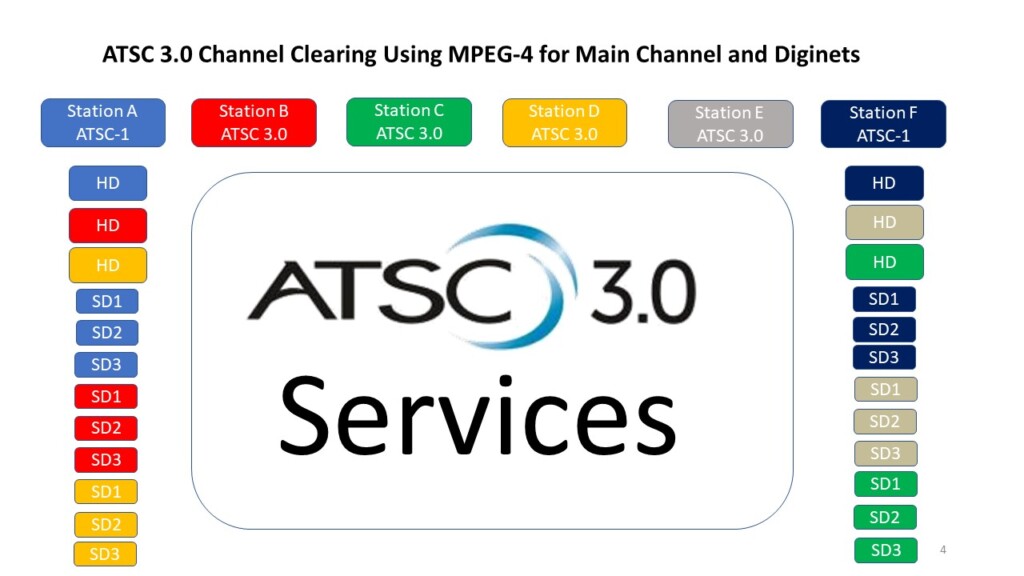Epilogue (and Prologue?)
A previous blog in this series noted that ATSC was engaged in the process of adapting the ATSC-1 DTV standard documentation so that it was compliant with MPEG-4 (also known as AVC) video coding implementations that are known to work in the marketplace with legacy receivers. That work was completed with the approval of A/53 Part3: 2013 Amendment No. 1 “AVC Signal Transport” on February 15, 2023, now available on the ATSC website. The amendment makes two basic changes:
- Adds the ATSC Standard on AVC coding (A/72 Part 1-Video System Characteristics of AVC in the ATSC Digital Television System) as a normative standard in the ATSC-1 DTV standard.
- Adds AVC coding to the acceptable compression schemes for the “service type” identified as ATSC Digital Television.
Essentially, this means:
- For broadcasters that are currently transmitting MPEG-4 coded signals for diginets: Continue to do what you’ve been doing, nothing has changed for broadcaster transmissions.
- For television set manufacturers with products in the field: All your existing products will work the same as they have been working, and fielded smart TVs will continue to decode and display MPEG-4 signals.
- For television set manufacturers’ future product designs: You should begin to intentionally include and test MPEG-4 reception capability in accordance with the now-amended ATSC DTV standard in all future television sets in both ATSC-1 and ATSC 3.0 product designs.
- For broadcasters contemplating using MPEG-4 for diginets: Deployment is feasible now and as time passes you can have increased confidence that MPEG-4 coded diginets will be able to reach an increasingly higher portion of the TV sets in your market.
Part 2 of this blog series showed that in a hypothetical market of six broadcast stations, each with one HD signal and three diginets, converting the diginets to MPEG-4 coding and initiating channel sharing with other stations in the market could theoretically allow three of the six stations to be used for ATSC 3.0, compared to two stations if only MPEG-2 compression was used. That’s a 50/50 split for ATSC-1/ATSC 3.0 bandwidth, enough to really show off some of ATSC 3.0’s incredible benefits and features. But in the pursuit of gaining even more ATSC 3.0 bandwidth, the idea of converting broadcasters’ primary programs (as defined by the FCC) to MPEG-4 is tantalizing; NAB recently suggested that the FCC develop criteria for allowing this scenario in the future. If approved by the FCC, this would allow two thirds of the six channels in the hypothetical market to be used for ATSC 3.0 services while all ATSC-1 programming was combined on two “lighthouse” (or more appropriately, “nightlight”) stations, as shown in the figure below.

Figure 1 Using MPEG-4 coding for all programs, four of six broadcast channels could be used for ATSC 3.0 NextGen TV transmissions in a hypothetical market with six stations, each with one HD and three SD programs.
That’s enough ATSC 3.0 bandwidth for all six stations to transmit 4K programming, along with their diginets, as well as some mobile services and/or data broadcasts, truly starting to deliver on the ATSC 3.0 promise of new advanced and innovative services for the public.
For those that choose not to upgrade their TV viewing to ATSC 3.0, as the famous motel advertising slogan goes: “We’ll keep the light on for you” with nightlight stations, as long as they’re needed, but not any longer. Eventually it will be “lights out” for ATSC-1, completing the full conversion to ATSC 3.0, bringing an end to the revolutionary-in-its-time DTV broadcast service, but allowing the evolution-friendly ATSC 3.0 service to shine brightly on all broadcast channels.

